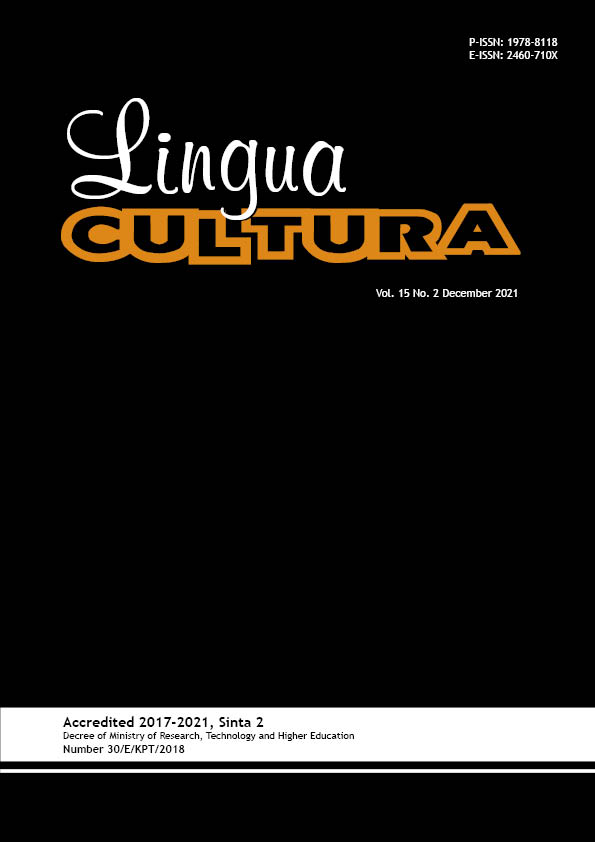On Google Translate: Students’ and Lecturers’ Perception of the English Translation of Indonesian Scholarly Articles
DOI:
https://doi.org/10.21512/lc.v15i2.7335Keywords:
Google Translate, translation assessment, users’ perception, translation acceptability, translation readabilityAbstract
The research investigated the translation results of Google Translate based on the users’ perceptions. It was aimed at describing the users’ frequency in using Google Translate web, finding the users’ perceptions on the acceptability and the readability of Google Translation in translating scholarly articles from Indonesian into English, as well as finding whether students and lecturers have the same perceptions regarding these two criteria. The data were collected from scholarly articles written in Indonesian then translated into English using Google Translate web. Then a survey regarding this translation was distributed to users; they were students and lecturers of Computer Science/Information Technology/Information System. The analysis was conducted with regard to the acceptability and the readability of the translations using a rating scale of translation assessment. The findings suggest that more than half of the participants often use Google Translate Web, which means that the academics are part of the users of Google Translate. However, students and lecturers have a rather different perception of the results of Google Translate. Students consider Google Translate quite acceptable and readable, while lecturers view Google Translate as rather acceptable and moderately readable. In addition, the findings indicate that, to some extent, Google Translate still translates the Indonesian text into English literally.
References
Aiken, M. (2019). An updated evaluation of Google Translate accuracy. Studies in Linguistics and Literature, 3(3), 253-260. http://dx.doi.org/10.22158/sll.v3n3p253.
Alsalem, R. (2019). The effects of the use of Google Translate on translation students’ learning outcomes. Arab World English Journal for Translation and Literary Studies, 3(4), 46-60. https://dx.doi.org/10.2139/ssrn.3483771.
Arsyad, S., Purwo, B. K., Sukamto, K. E., & Adnan, Z. (2019). Factors hindering Indonesian lecturers from publishing articles in reputable international journals. Journal on English as a Foreign Language, 9(1), 42-70.
Brahmana, C. R. P. S., Sofyan, R., & Putri, D. M. (2020). Problems in the application of Google Translate as a learning media in translation. Language Literacy: Journal of Linguistics, Literature, and Language Teaching, 4(2), 384-389. https://doi.org/10.30743/ll.v4i2.2893.
Habeeb, L. S. (2019). Investigate the effectiveness of Google Translate among Iraqi students. Opcion, 35(21), 2899-2921.
Hartono., Arjanggi, R., & Praptawati, D. (2019). Self-efficacy of Indonesian non-English lecturers in writing English academic papers for international publication. Advances in Social Science, Education and Humanities Research, 188, 28-31. https://dx.doi.org/10.2991/eltlt-18.2019.6.
Hoi, H. T. (2020). Machine translation and its impact in our modern society. International Journal of Scientific and Technology Research, 9(2), 1918-1921.
Karjo, C. H., & Metta, E. (2019). The translation of lexical collocations in undergraduate students’ theses’ abstract: Students versus Google Translate. Lingua Cultura, 13(4), 289-296. https://doi.org/10.21512/lc.v13i4.6067.
Kartika, D., & Priyatmojo, A. S. (2018). Analysis of Google Translate’s quality in employing translation techniques. Journal of English Language Teaching, 7(1), 40-49.
Khosravizadeh, P., & Pashmforoosh, R. (2011). Google Translation: A semantic structure analysis. Retrieved from https://www.researchgate.net/publication/216597782_Google_Translation_A_Semantic_Structure_Analysis.
Larson, M. L. (1998). Meaning-based translation: A guide to cross-language equivalence (2nd Ed.). Maryland, USA: University Press of America.
Nababan, M., Nuraeni, A., & Sumardiono. (2012). Pengembangan model penilaian kualitas terjemahan. Kajian Linguistik dan Sastra, 24(1), 39-57.
Setiyadi, D., Kuswardani, Y., Sari, D. K., & Martanti, D. A. (2020). Analyzing on English-Indonesian culture – Specific concept translation by Google Translate. International Journal of Scientific & Technology Research, 9(1), 2242-2246.
Siregar, R., Risnawaty, R., Arfanti, Y., & Sembiring, M. (2020). Reflection of undergraduate students on translation process: An outlook of translation teaching in university. Lingua Cultura, 14(1), 57-67. https://doi.org/10.21512/lc.v14i1.6232.
Valijärvi, R. L., & Tarsoly, E. (2019). Language students as critical users of Google Translate: Pitfalls and possibilities. Practitioner Research in Higher Education, 12(1), 61-74.
Downloads
Published
How to Cite
Issue
Section
License
Copyright (c) 2021 Menik Winiharti, Syihabuddin Syihabuddin, Dadang Sudana

This work is licensed under a Creative Commons Attribution-ShareAlike 4.0 International License.
Authors who publish with this journal agree to the following terms:
a. Authors retain copyright and grant the journal right of first publication with the work simultaneously licensed under a Creative Commons Attribution License - Share Alike that allows others to share the work with an acknowledgment of the work's authorship and initial publication in this journal.
b. Authors are able to enter into separate, additional contractual arrangements for the non-exclusive distribution of the journal's published version of the work (e.g., post it to an institutional repository or publish it in a book), with an acknowledgment of its initial publication in this journal.
c. Authors are permitted and encouraged to post their work online (e.g., in institutional repositories or on their website) prior to and during the submission process, as it can lead to productive exchanges, as well as earlier and greater citation of published work.
USER RIGHTS
All articles published Open Access will be immediately and permanently free for everyone to read and download. We are continuously working with our author communities to select the best choice of license options, currently being defined for this journal as follows: Creative Commons Attribution-Share Alike (CC BY-SA)


















